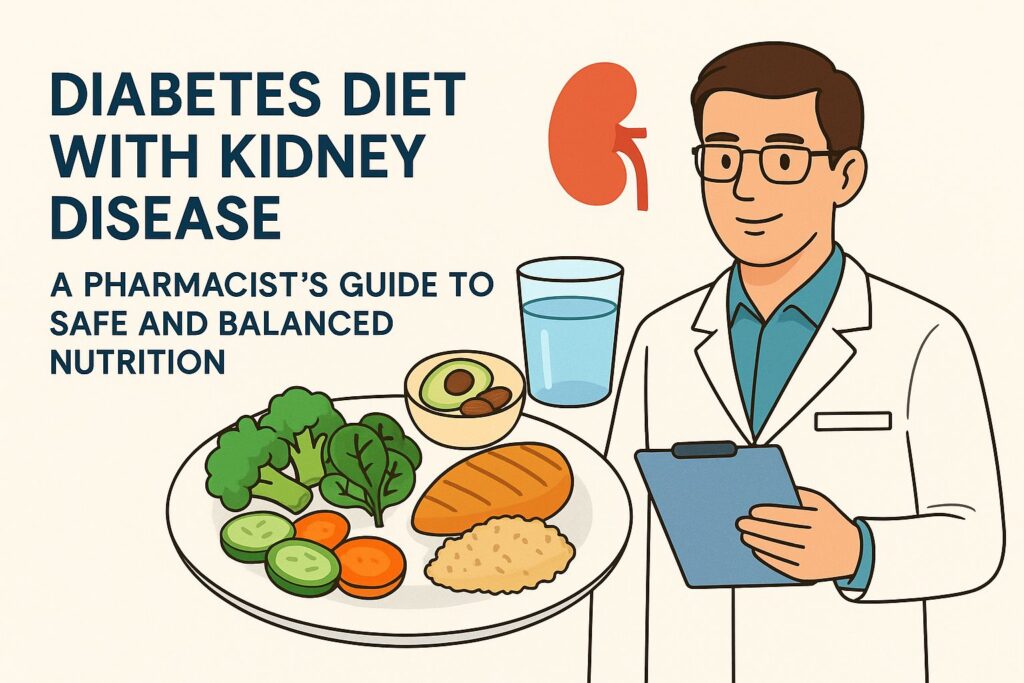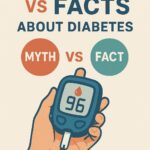Managing diabetes is already a daily balancing act—but when kidney disease enters the picture, the challenge becomes even more complex. As a licensed pharmacist, I’ve worked closely with patients facing both of these chronic conditions. One of the most common questions I hear is: “What should I eat if I have diabetes and kidney disease?”
The right diet can slow the progression of kidney damage, improve blood sugar control, and help you feel better overall. However, it requires a thoughtful approach—because some foods that are healthy for diabetes may not be ideal for your kidneys, and vice versa.
In this guide, I’ll walk you through a medically responsible and evidence-based approach to building the best daily diet for diabetes with kidney disease. We’ll cover food choices, meal timing, essential nutrients, and what to avoid—all tailored to protect kidney function and manage blood sugar levels effectively.
(diabetes diet with kidney disease)
Understanding the Link Between Diabetes and Kidney Disease
What is Diabetic Kidney Disease?
Diabetic kidney disease (DKD), also known as diabetic nephropathy, is a long-term complication of diabetes that affects the kidneys’ ability to filter waste from the blood. High blood sugar levels can damage the delicate blood vessels (glomeruli) in your kidneys over time, leading to reduced function or even kidney failure.
According to the National Kidney Foundation, diabetes is the leading cause of chronic kidney disease (CKD) in the world. Up to 40% of people with diabetes may eventually develop some level of kidney impairment.
The Silent Progression of Kidney Damage
One of the challenges with diabetic kidney disease is that it often develops silently. You might not notice symptoms until the damage is advanced. That’s why early dietary intervention is critical. Simple nutrition tweaks—such as reducing sodium, controlling protein intake, and watching potassium—can dramatically improve your outcomes.
Stages of Chronic Kidney Disease (CKD)
CKD is measured in five stages, based on your eGFR (estimated glomerular filtration rate):
| CKD Stage | eGFR (ml/min) | Description |
| Stage 1 | 90+ | Normal function with damage signs |
| Stage 2 | 60-89 | Mild kidney damage |
| Stage 3 | 30-59 | Moderate loss of function |
| Stage 4 | 15-29 | Severe decline |
| Stage 5 | <15 | Kidney failure (ESRD) |
Important: Your dietary needs vary by stage. For example, protein intake may be restricted in Stage 3 or later.
Why Diet Matters So Much
Think of your kidneys as your body’s natural filtration system. When they’re damaged, they can no longer filter excess fluids, waste, or certain nutrients (like potassium and phosphorus) effectively. At the same time, uncontrolled diabetes makes things worse by spiking blood sugar levels, which damages kidneys further.
That’s why your diet must serve two goals:
1. Support healthy blood sugar control
2. Reduce stress on the kidneys by managing key nutrients
And this is exactly what we’ll explore in the next sections—foods to include, what to avoid, sample meal plans, and the most common mistakes to watch for.
Core Dietary Goals for Diabetic Kidney Disease
When managing diabetes alongside kidney disease, your diet needs to achieve multiple health objectives at once—sometimes even in conflict. That’s why working with your healthcare team (dietitian, nephrologist, pharmacist) is essential.
As a pharmacist, here’s how I explain the four primary dietary goals to my patients dealing with this dual condition:
1. Control Blood Sugar Levels (Glucose Management)
Why it matters: High blood glucose damages the kidney’s filtering units and accelerates diabetic kidney disease (DKD). Eating the right type and amount of carbohydrates is key.
Tips:
• Focus on low glycemic index (GI) carbohydrates like quinoa, lentils, and oats.
• Eat consistent portion-controlled meals to avoid sugar spikes.
• Pair carbs with protein or healthy fat to reduce the GI impact.
Recommended Foods:
• Whole grains (in moderation)
• Non-starchy vegetables
• Small portions of fruit (e.g., apples, berries)
2. Regulate Protein Intake
Why it matters: While protein is essential, too much can strain the kidneys. In later stages of CKD (Stage 3–5), protein restriction is often recommended.
Guidelines:
• For early-stage CKD: Moderate protein intake (~0.8g/kg/day)
• For advanced CKD (non-dialysis): May need further restriction (~0.6g/kg/day)
• For patients on dialysis: Higher protein needs (~1.0–1.2g/kg/day)
Choose:
• Lean sources like skinless chicken, fish, tofu, eggs, Greek yogurt (in moderation)
Avoid:
• Processed meats, high-fat red meats, excess protein supplements
3. Limit Sodium Intake
Why it matters: Sodium control helps manage blood pressure—crucial for protecting both kidneys and the heart. It also helps reduce fluid retention.
Daily limit:
<2,300 mg/day (often less depending on blood pressure goals)
Tips:
• Read labels—look for low-sodium or no-salt-added options
• Cook at home using herbs/spices instead of salt
• Avoid canned soups, fast food, and salty snacks
4. Monitor Potassium and Phosphorus
As kidney function declines, it becomes harder to remove excess potassium and phosphorus, which can lead to heart issues, nerve problems, and bone loss.
High-Potassium Foods to Limit:
• Bananas, oranges, tomatoes, potatoes, spinach, avocados
Safer Alternatives:
• Apples, berries, cucumber, zucchini, white rice, cabbage
High-Phosphorus Foods to Avoid:
• Dairy products (milk, cheese)
• Nuts and seeds
• Dark colas, processed meats
• Packaged foods with “phos-” ingredients
Safer Alternatives:
• Rice milk (phosphorus-free)
• Cauliflower, egg whites
• Homemade meals without additives
Summary Table: Nutritional Focus
| Nutrient | Goal | Tips |
| Carbs | Low-GI, controlled portions | Pair with protein/fat, choose whole foods |
| Protein | Moderate (varies by CKD stage) | Focus on lean sources, avoid excess |
| Sodium | <2,300 mg/day or less | Avoid processed foods, read labels |
| Potassium | Adjust based on labs | Limit high-K foods, switch to low-k veggies/fruits |
| Phosphorus | Limit with CKD progression | Avoid additives, dairy, seeds, and dark sodas |
Pharmacist’s Note:
Patients with diabetes and kidney disease often need personalized dietary adjustments based on lab results—especially for potassium and phosphorus. If your labs show elevated levels, your doctor or dietitian may suggest medications like phosphate binders or potassium-reducing therapies.
Pro Tip:
Always read ingredient labels. Phosphorus additives are often hidden and are more absorbable than natural phosphorus in food.
Best and Worst Foods for Diabetes &Kidney Disease
Crafting the right meal plan when managing both diabetes and kidney disease can feel overwhelming—but it doesn’t have to be. As a pharmacist working with patients on this journey, I’ve seen firsthand that simple, smart food choices can make a huge difference in outcomes.
Here’s a clear breakdown of what you can eat, what to limit, and what to avoid completely.
Best Foods to Eat
These foods support blood sugar stability, reduce kidney workload, and provide essential nutrients without overloading on harmful minerals.
Non-Starchy Vegetables
• Examples: Cabbage, cauliflower, cucumber, bell peppers, carrots, zucchini, lettuce
• Why: Low in carbs and potassium, rich in fiber and antioxidants
Whole Grains (in moderation)
• Examples: Steel-cut oats, brown rice (limited), quinoa, barley
• Why: Provide fiber and slow-digesting carbs for steady glucose control
Lean Protein Sources
• Examples: Egg whites, skinless chicken, fish (like salmon or cod), tofu
• Why: Essential for tissue repair with less kidney stress (especially in early CKD)
Low-Potassium Fruits
• Examples: Apples, berries, grapes, peaches, pineapple
• Why: Nutrient-dense, safe for potassium-sensitive individuals
Healthy Fats
• Examples: Olive oil, avocado (in limited amounts), flaxseed, walnuts
• Why: Support heart health without burdening kidneys
Hydration & Fluids
• Tip: Water is best. Discuss total fluid limits with your provider, especially in later CKD stages.
Foods to Limit
These foods can be part of your diet, but only in controlled amounts or based on lab results.
Animal Proteins (moderate)
• Limit red meat and full-fat dairy
• Choose smaller portions (about the size of a deck of cards)
High-Potassium Fruits (small servings only if allowed)
• Bananas, oranges, mangoes, kiwis
Refined Carbohydrates
• White bread, sugary cereals, baked goods
• Cause rapid blood sugar spikes
Dairy Products
• Milk, cheese, cream—high in both phosphorus and saturated fat
Sodium-Rich Items
• Canned foods, sauces, salty snacks, processed meats
Foods to Avoid Completely
Some foods are best eliminated entirely when managing both conditions, especially if lab values are elevated.
| Category | Avoid |
| Processed Meats | Bacon, sausages, ham, hot dogs, deli meats |
| Packaged junk foods | Chips, instant noodles, frozen pizzas, snack cakes |
| High phosphorus drinks | Dark sodas (cola), chocolate milk, processed energy drinks |
| High sodium foods | Pickle, soy sauce, canned soups, seasoning mixes with MSG |
| Potassium additives | Potassium chloride-based salt substitute (e.g., No salt, Lite salt) |
Sample Kidney-Friendly Grocery List for Diabetics
Vegetables:
• Carrots, green beans, bell peppers, cabbage, lettuce, cucumber
Fruits:
• Apples, strawberries, grapes, blueberries
Proteins:
• Egg whites, chicken breast, tofu, salmon
Grains:
• Oats, quinoa, small portions of brown rice
Fats:
• Olive oil, flaxseed, small amounts of avocado
Snacks:
• Unsalted rice cakes, air-popped popcorn (no butter), raw vegetables
Meal Prep Tips
• Batch cook lean proteins and low-potassium vegetables
• Freeze meals in labeled containers with portion sizes
• Avoid seasoning with salt—use garlic, lemon juice, rosemary, basil instead
• Use a food tracker app to monitor carb, potassium, and sodium intake

Sample 1-Day Meal Plan for Diabetes with Kidney Disease
Creating a daily meal plan that supports stable blood sugar while reducing strain on the kidneys requires a thoughtful balance of nutrients. As a licensed pharmacist, I’ve helped many patients manage both conditions by structuring their meals with portion control, timing, and the right ingredients.
Below is a practical and realistic 1-day meal plan tailored for someone managing both Type 2 Diabetes and Chronic Kidney Disease (CKD).
Overview of the Day
| Meal | Time | Focus |
| Breakfast | 7:30 AM | Complex carbs + Lean protein |
| Mid-Morning snack | 10:00 AM | Fiber rich fruit + Hydration |
| Lunch | 1:00 PM | Non starchy veggies + Healthy carbs |
| Afternoon snack | 4:00 PM | Light protein + Healthy fat |
| Dinner | 7:00 PM | Low sodium + Low potassium + Protein |
| Optional | 9:00 PM | Small, controlled late snack if needed |
Breakfast (7:30 AM)
Meal:
• ½ cup steel-cut oats (cooked with water)
• 1 tablespoon flaxseeds
• ½ small apple, diced (peeled)
• 1 boiled egg white
• Herbal tea or warm water
Why It Works:
• Slow-digesting carbs to prevent glucose spikes
• Low potassium and phosphorus
• Fiber supports both blood sugar and kidney health
Mid-Morning Snack (10:00 AM)
Snack:
• A small handful of blueberries (~½ cup)
• 1 glass of water with lemon
Why It Works:
• Low potassium fruit with antioxidants
• Keeps blood sugar steady between meals
Lunch (1:00 PM)
Meal:
• Grilled chicken breast (about 3 oz)
• 1 cup steamed green beans and carrots
• ½ cup quinoa
• 1 teaspoon olive oil for dressing
• Cucumber slices + lemon water
Why It Works:
• Balanced protein-carb-veggie combo
• Low sodium, low potassium, diabetic-friendly carbs
Afternoon Snack (4:00 PM)
Snack:
• 1 ounce unsalted rice cakes
• 1 tablespoon natural peanut butter (no added salt)
• Herbal tea or water
Why It Works:
• Energy boost without overloading kidneys
• Keeps blood sugar stable before dinner
Dinner (7:00 PM)
Meal:
• Grilled white fish (tilapia or cod – 3 oz)
• ½ cup sweet potatoes (baked, no skin)
• 1 cup steamed cabbage
• Water with a slice of cucumber or mint
Why It Works:
• Low-GI carbs, lean protein, low potassium vegetables
• Easy on digestion and blood glucose
Optional Evening Snack (9:00 PM)
Snack (if advised by your doctor):
• ¼ cup unsweetened Greek yogurt
• A sprinkle of cinnamon
Why It Works:
• Helps avoid overnight blood sugar dips
• Protein-rich, phosphorus-controlled (choose renal-safe brand)
Table: Daily Nutrient Summary (Approximate)
| Nutrient | Value (approximate) |
| Total calories | 1,600-1,800 kcal |
| Total carbs | 150-180g (low GI focus) |
| Protein | 60-70g (CKD-appropriate) |
| Sodium | <1,500mg |
| Potassium | Controlled (~2,000mg) |
| Phosphorus | Controlled (<800mg) |
Note: Actual requirements vary by individual stage of kidney disease. This is a general guide, not a medical prescription.
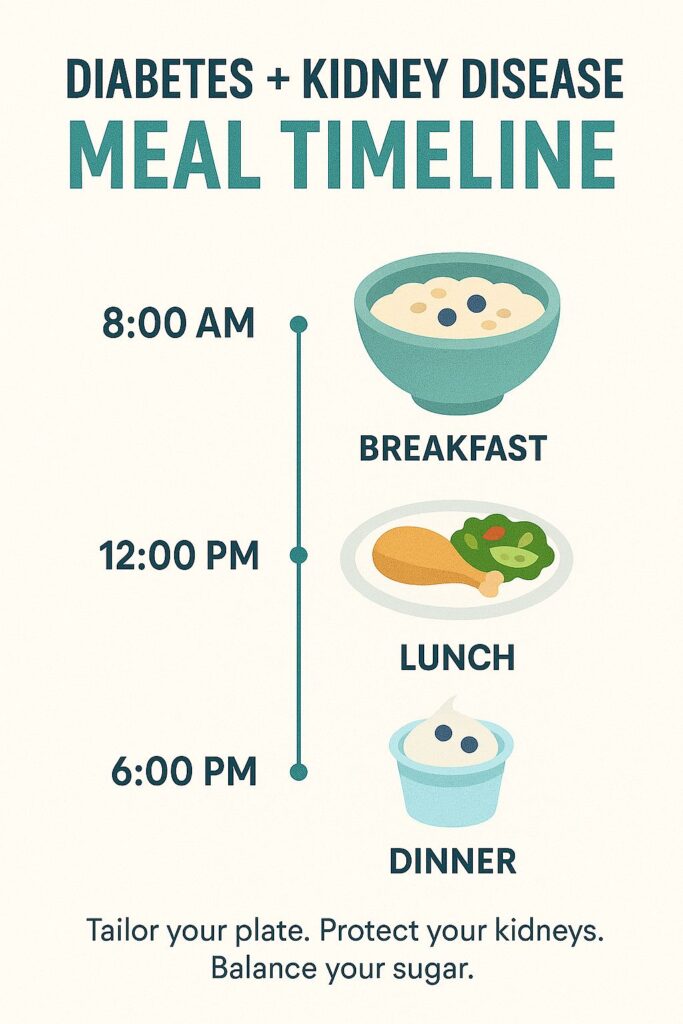
Lifestyle Tips Beyond Diet for Managing Diabetes and Kidney Disease
While diet plays a central role in managing both type 2 diabetes and chronic kidney disease (CKD), your daily lifestyle habits are equally important for long-term success. As a licensed pharmacist, I’ve seen firsthand how strategic changes in activity, hydration, medication, and stress management can significantly reduce complications and improve quality of life.
Here’s a pharmacist-recommended guide to key lifestyle strategies:
1. Daily Physical Activity (30 Minutes Minimum)
Why it matters:
Exercise increases insulin sensitivity, improves circulation, and helps reduce blood pressure—crucial for kidney protection.
Safe activity ideas:
• Brisk walking
• Gentle yoga or chair yoga
• Stationary cycling
• Light swimming (if approved by your doctor)
Tips:
• Avoid intense exercise without medical clearance
• Stay hydrated—especially with kidney conditions
• Monitor your glucose levels pre- and post-activity
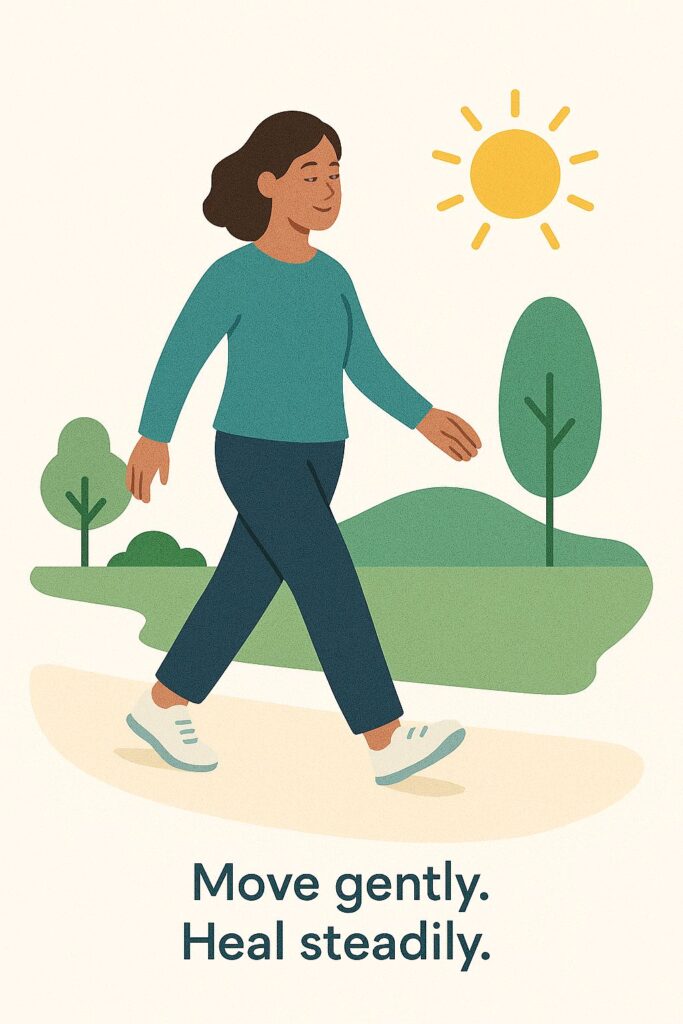
2. Medication Management
Why it matters:
Both diabetes and kidney disease require regular medication. Missed doses or incorrect timing can worsen both conditions.
Best practices:
• Use a pill organizer or digital reminder app
• Follow your doctor’s dosing instructions carefully
• NEVER self-adjust insulin or blood pressure meds without approval
• Be cautious with over-the-counter drugs—many (like NSAIDs) harm kidneys
Ask your pharmacist to review all medications, including supplements, for kidney safety.
3. Monitor Fluid and Sodium Intake
Why it matters:
Too much fluid can cause swelling and high blood pressure in kidney disease. Sodium (salt) worsens both glucose and renal function.
Tips:
• Limit salt to under 1,500 mg/day
• Track fluid intake if advised by your nephrologist
• Choose low-sodium alternatives (check food labels)
• Avoid processed and canned foods
Kidney-safe hydration:
• Water infused with mint or cucumber
• Herbal teas (check potassium content)
• Avoid sugary sodas, sports drinks, and high-phosphorus beverages (like cola)

4. Prioritize Sleep and Stress Reduction
Why it matters:
Poor sleep and chronic stress raise cortisol, which increases blood sugar and blood pressure—damaging kidneys over time.
Sleep tips:
• Aim for 7–8 hours of quality sleep per night
• Maintain consistent sleep and wake times
• Avoid screens before bed
Stress reduction strategies:
• Meditation or deep breathing
• Gratitude journaling
• Nature walks
• Talk therapy or support groups
😌 Mind-body balance = better glycemic and renal control.

5. Monitor Lab Tests Regularly
Why it matters:
Routine tests help catch kidney and diabetes complications early. You should be regularly checking:
| Test | Frequency | Purpose |
| HbA1c (Blood sugar avg) | Every 3-6 months | Measures long term blood sugar control |
| eGFR (Kidney filtration rate) | Every 3-6 months | Assesses kidney function |
| Urine microalbumin | Annually | Detects early kidney damage |
| Serum Creatinine & electrolytes | Every 3-6 months | Monitor kidney waste levels and balance |
| Lipid profile | Annually | Checks for heart disease risk (common in CKD) |
Discuss your test results with your doctor and pharmacist—they can help you adjust lifestyle or meds accordingly.
Key Tools to Support You
Consider these helpful tools:
• Glucose tracking app (e.g., mySugr, Glucose Buddy)
• Meal planner for CKD/diabetes (e.g., Kidney Kitchen, ADA recipes)
• Digital reminders for water, meds, and exercise
• Online community: Connect with others via forums or Facebook groups for peer support
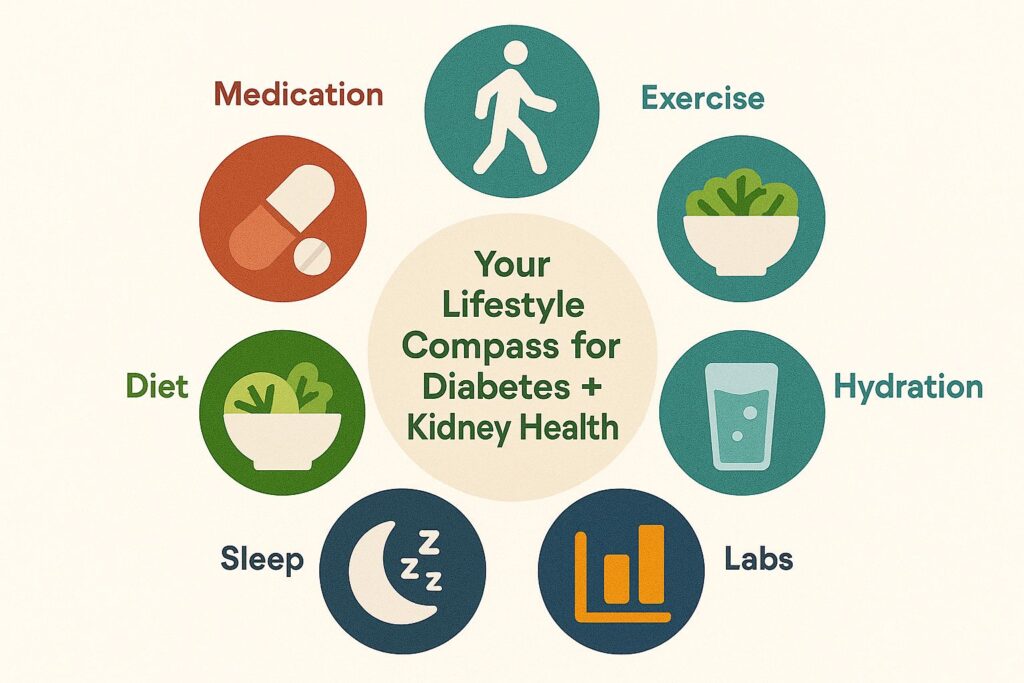
Important Food Restrictions and Smart Substitutions for Diabetes with Kidney Disease
When you’re managing both type 2 diabetes and chronic kidney disease (CKD), food choices must do double duty: regulating blood sugar and protecting your kidneys. Certain healthy foods for diabetes may be problematic for kidneys—and vice versa.
As a licensed pharmacist, I often help patients navigate this overlap by identifying foods that support both conditions without compromising one for the other.
Let’s explore:
Foods to Limit or Avoid
| Food/Ingredient | Why to Avoid |
| High potassium foods (in advance CKD) | Can cause dangerous heart rhythms due to excess potassium |
| High phossphorus foods | Damages bones and blood vessels in CKD patients |
| Sugary snacks/drinks | Spikes blood sugar and increase fat storage |
| Sodium/salt heavy items | Raise blood pressure, damages kidney filtration |
| Processed meats | High in salt and preservatives, harmful to kidneys |
| Whole milk & full-fat dairy | High in saturated fat and phosphorus |
Important: Potassium and phosphorus needs vary depending on your CKD stage. Always follow your doctor or renal dietitian’s guidance.
Smart Substitutions (Diabetes + Kidney Friendly)
| Instead of… | Choose… |
| White bread, rice, or pasta | Whole grain (small portions)). quinoa, barley (if potassium OK) |
| Bananas, oranges | Apples, berries, grapes, pineapple (lower potassium fruits) |
| Potatoes | Sweet potatoes (leached), cauliflower mash |
| Red meat | Grilled fish, egg whites, tofu, skinless poultry |
| Sugary Drinks | Water, infused water, unsweetened herbal teas |
| Full-fat dairy | Unsweetened almond milk, low phosphorus dairy substitutes |
| Chips & salty snacks | Unsalted popcorn, raw vegetables with hummus |
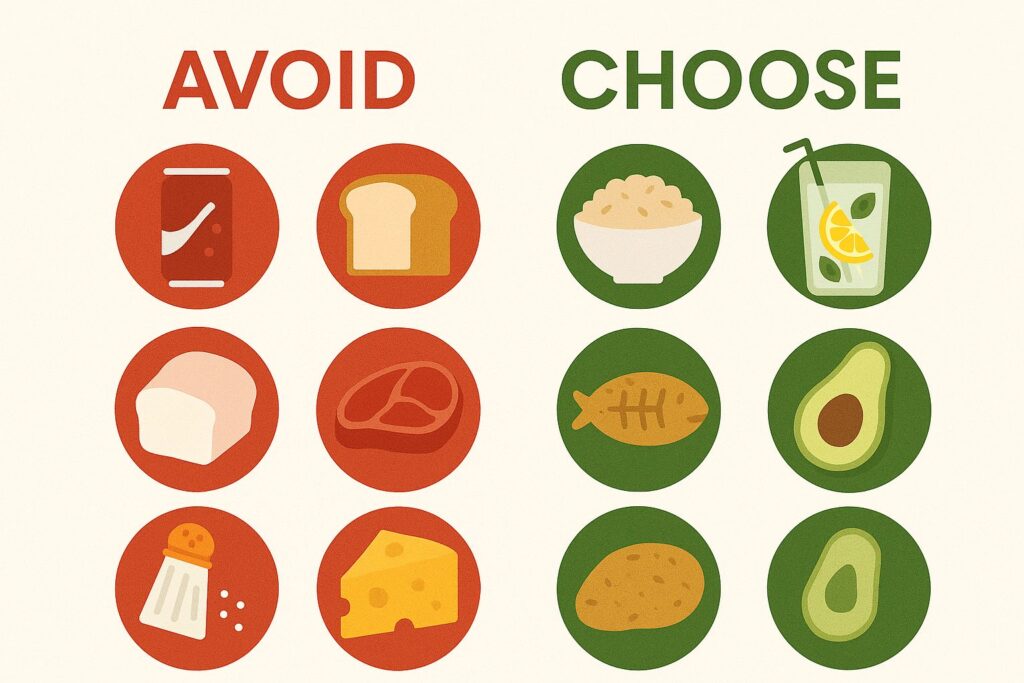
Diabetes & Kidney-Friendly Superfoods
These foods are generally safe and beneficial (but confirm with your provider):
• Cabbage – Low in potassium, fiber-rich
• Berries – Packed with antioxidants, low glycemic load
• Salmon – Rich in omega-3s (choose low-sodium)
• Garlic – Flavor enhancer without salt
• Cucumber & zucchini – Kidney-friendly, hydrating
• Egg whites – High-quality protein without phosphorus overload
• White rice (in moderation) – Less potassium/phosphorus than brown rice
Portion control is essential. Even healthy foods can spike blood sugar or strain kidneys if eaten in excess.
Special Note: Phosphorus and Potassium Additives
Check food labels for hidden additives like:
• Potassium chloride
• Sodium phosphate
• Phosphoric acid
These are common in:
• Cola drinks
• Processed cheese
• Deli meats
• Instant pudding
• Fast foods
Tip: Choose “phosphate-free” or “kidney-friendly” labeled items when possible.
Sample Diabetes-Kidney Safe Meal Plan (1 Day)
| Meal | Example |
| Breakfast | Oatmeal with almond milk, blueberries, and a sprinkle of chia seeds |
| Snack | Apple slices with a tablespoon of unsalted peanut butter |
| Lunch | Grilled salmon, steamed green beans, small quinoa serving |
| Snack | Cucumber slices with low-phosphorus hummus |
| Dinner | Baked tofu with sauteed spinach and leached sweet potato mash |
| Beverages | Water, lemon water, or herbal tea |
Bonus Tip: Practice “Leaching” High-Potassium Veggies
Leaching is a cooking technique that removes excess potassium from vegetables.
How to do it:
1. Peel and cut veggies into small pieces
2. Soak in warm water for 2 hours
3. Rinse and boil in fresh water
This works well for:
• Potatoes
• Carrots
• Beets
• Sweet potatoes
“Leaching” makes occasional higher-potassium veggies safer for CKD patients with diabetes.
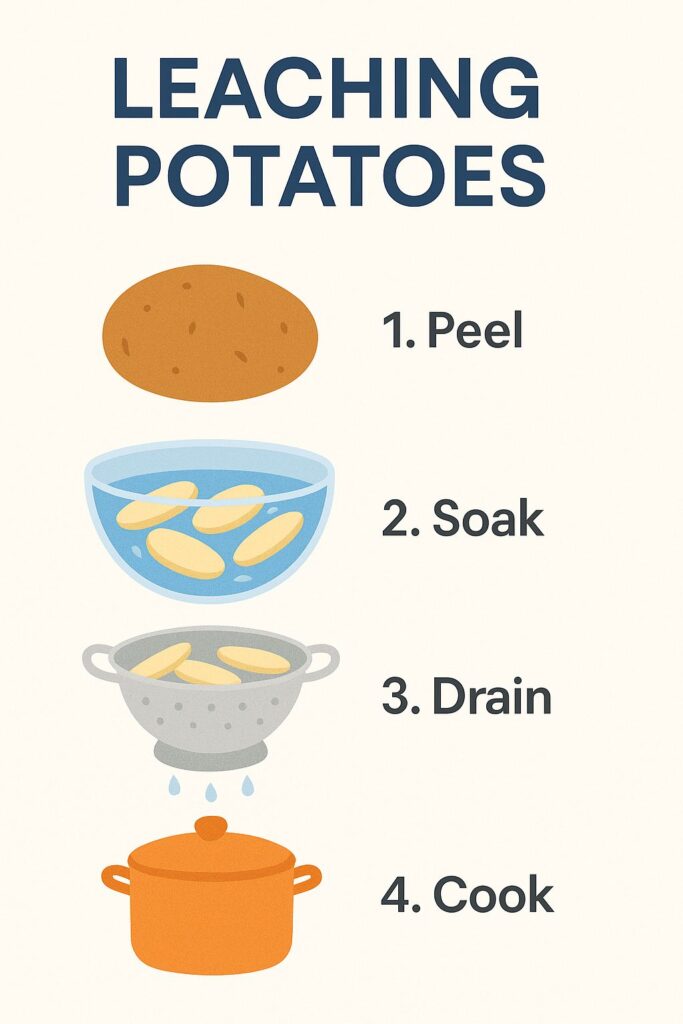
Key Takeaways: Eating Right for Diabetes & Kidney Disease
Managing diabetes alongside kidney disease can be challenging—but with the right daily diet, you can protect your kidneys and maintain blood sugar control. Let’s recap:
• Control carbs: Stick to low-GI, high-fiber options in moderation.
• Watch protein: Choose lean proteins and consult your provider on the right amount.
• Limit sodium: Helps reduce blood pressure and kidney strain.
• Monitor potassium & phosphorus: Especially in advanced CKD—read food labels carefully.
• Stay hydrated: Choose water and avoid sugary or phosphate-rich drinks.
• Plan meals: Balanced portions help stabilize both glucose and kidney load.
Tip from a Pharmacist: Always ask your doctor or renal dietitian before making major dietary changes, especially if you’re on medications like insulin, ACE inhibitors, or phosphate binders.
FAQs – Diabetes Diet with Kidney Disease
Can I still eat fruits if I have diabetes and kidney disease?
Yes, but choose low-potassium, low-glycemic fruits like apples, berries, and grapes. Limit high-potassium fruits such as bananas and oranges.
Should I follow a high-protein or low-protein diet?
For kidney disease, too much protein can be harmful, even if it’s helpful for blood sugar. Stick to moderate protein intake (as guided by your doctor) and prefer plant-based or lean animal sources.
Is oatmeal good for diabetes with kidney disease?
Yes, in moderation. Oats have a low glycemic index and are generally low in phosphorus and potassium. Use water or almond milk instead of cow’s milk.
Can I drink milk?
Most dairy products are high in phosphorus and saturated fat. Instead, use unsweetened plant-based alternatives like almond or rice milk (check labels for phosphate additives).
Are sweet potatoes okay if I have CKD and diabetes?
Yes—if leached and eaten in moderation. Sweet potatoes are a great low-GI carb but are also high in potassium, so preparation and portion control matter.
Medical Disclaimer
This article is for informational purposes only and is not a substitute for professional medical advice, diagnosis, or treatment. Always consult your physician, dietitian, or healthcare provider before making changes to your diet, especially if you have diabetes or kidney disease.
